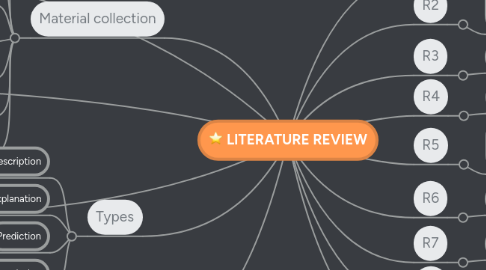LITERATURE REVIEW
by Mo Khabbaz


1. Goals
1.1. clarify alternative views of past research
1.2. Explain the results of prior research found within research streams
1.3. summarize prior research
1.4. Examine contributions of past research
2. Strategies
2.1. Mayring Ideal Type
2.2. Descriptive review
2.2.1. emphasize on descriptive analysis
2.3. New framework based review
2.3.1. emphasis on the framework
2.4. Theory-based
2.4.1. emphasis on the material evaluation stage
3. Types
3.1. Analysis and Description
3.2. Explanation
3.3. Prediction
3.4. prescription
4. Based on
4.1. conceptual frameworks
4.2. descriptive models
4.3. theories
5. Definition
5.1. "A research literature review is a systematic, explicit and reproducable method for identifying, evaluating and synthesizing the existing body of completed and recorded work produced by researchers, scholars, and practitioners"
6. Material collection
6.1. Selecting a research question
6.2. Selecting bibliographic or article databases, websites and other sources.
6.3. Choosing search terms.
6.4. Applying practical screening criteria
6.5. Applying methodological screening criteria
6.6. Doing the review
6.7. Synthesizing the results
7. R1
7.1. Overarching principle of respect and coherence
8. R2
8.1. Gaps, biases and directions’: Literature reviews should strive to identify thematic gaps and theoretical biases
9. R3
9.1. Which contribution to theory goal?’
10. R4
10.1. ‘Descriptivereviews’: To be worthy
11. R5
11.1. A literature review does not have to be integrative like a theory or conceptual framework
12. R6
12.1. ‘Conceptual framework’
12.1.1. identify knowledge gaps and theoretical bias, and future research directions
